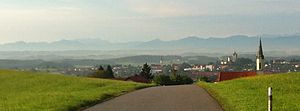| Battle of Ampfing (1800) | |||||||
|---|---|---|---|---|---|---|---|
| Part of the French Revolutionary War | |||||||
 The hilly terrain around Ampfing is characterized by open fields, dense woods, and villages and farms. | |||||||
| |||||||
| Belligerents | |||||||
|
|
| ||||||
| Commanders and leaders | |||||||
| Paul Grenier | Archduke John of Austria | ||||||
| Strength | |||||||
| 18,000[1] | 27,000[2] | ||||||
| Casualties and losses | |||||||
| 1,707[3] | 3,070[4] | ||||||
Austria
At the Battle of Ampfing on 1 December 1800, Paul Grenier's two divisions of the First French Republic opposed the Austrian army southwest of the town of Ampfing during the French Revolutionary Wars. The Austrians, under the leadership of Archduke John of Austria, forced their enemies to retreat, though they sustained greater losses than the French. Ampfing is located 63 kilometers (39 miles) east of Munich and 8 km (5.0 mi) west of Mühldorf am Inn.
In Spring 1800, while Moreau wrecked Austrian defenses in Germany, Generals Massena and Desaix ran into stiff Austrian offensives in Northern Italy. In June, Napoleon brought in the reserve corps and defeated the Austrians at Marengo. On the Danube, the decisive Battle of Höchstädt, followed by success at Battle of Neuburg a few days later, allowed the French to take Munich and to control the Danube and its tributaries as far as Ingolstadt. With the French pressing on Austria from the north and through Italy, a truce ended hostilities for the rest of the summer. Despite these significant losses—both of them decisive—the Austrians were reluctant to accept disadvantageous peace terms. After the expiration of the summer truce in November 1800, both the Austrian and French armies rushed to come to grips with each other in the terrain east of Munich. The newly appointed commander of Austrian forces, Archduke John, managed to bring the bulk of his army against Grenier's left wing of Jean Moreau's French army near Ampfing. Outnumbered, two French divisions fought a stubborn rear guard action for six hours before retreating in good order.
Instead of being sobered by their 3,000 casualties, Archduke John and his staff became convinced that the enemy was on the run. The Austrian general ordered a pursuit of the French through forested terrain. But, instead of fleeing, Moreau and his troops were waiting for the Austrians. The two armies met in the decisive Battle of Hohenlinden two days later.
- ^ James R. Arnold, Marengo & Hohenlinden. Barnsley, South Yorkshire, UK: Pen & Sword, 2005, pp. 274–275. This is the strength of Ney (9,600) and Hardy (6,300) at Hohenlinden, plus Ampfing casualties. Smith lists 35,000 engaged, which is more than Grenier's entire left wing.
- ^ Arnold, pp. 276–277. This is the strength of Riesch (13,300) and Latour (10,900) at Hohenlinden, plus Ampfing casualties
- ^ Arnold, p. 220. Smith gives French losses as 1,200 total. Arnold's casualties are more detailed and are used here.
- ^ Smith, p. 188
